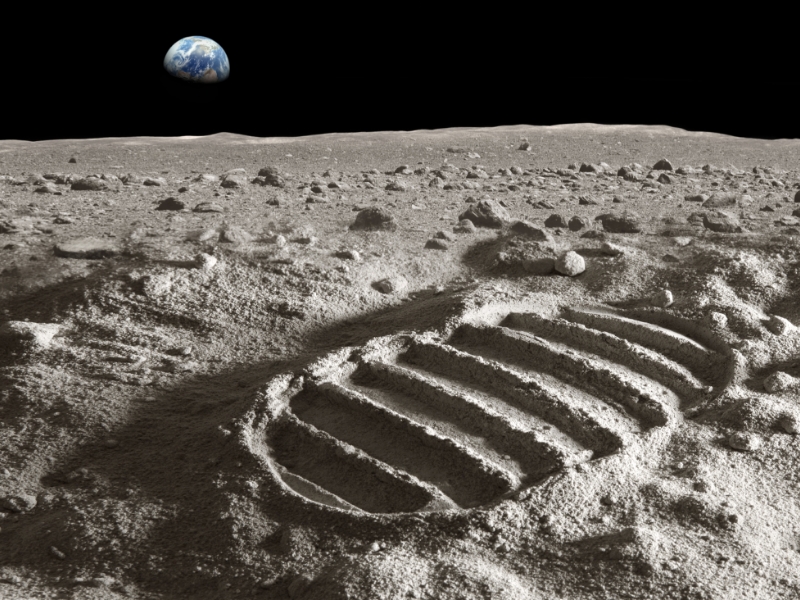Space Exploration
From the Space Race to a Gold Rush in Space?
There is a sense of optimism in space travel: The USA, China and India, as well as private individuals, have set themselves the goal of returning to the Moon and continuing into space. Will the hunt for raw materials in space soon begin?

If it had been up to the managers of the American airline Pan Am in the late 1960s, tourist flights to the Moon would have become part of everyday life today. The company would have had enough potential customers: Between 1968 and 1971, Pan Am issued over 90,000 First Moon Flights Club member cards, a waiting list for flights to the Moon.
A lot has happened since then. Or not. On December 14, 1972, Apollo 17 commander Gene Cernan was the last man to leave the Moon. A few years later, the space euphoria had vanished. Pan Am ceased operations in 1991. And so far, no one has flown to the Moon as a tourist.
But space fever has returned in recent years. “There’s another Space Race, mainly between China and the USA. We want to go back to the Moon and on to Mars,” says Peter Wurz, Director of the Physics Institute at the University of Bern. “The Chinese have achieved several “firsts’ with their Chang’e Moon missions, such as landing a rover on the far side of the Moon,” says Wurz. “These are things the Americans didn’t do. And that, of course, worries them.”
“Many things used to be simply not technically possible or far too expensive.”
Audrey Vorburger
Valentin Bickel, Fellow in Planetary Geomorphology at the Center for Space and Habitability at the University of Bern, seconds that: “Only recently, the Indians landed near the south pole of the Moon with Chandrayaan-3. The lander took off once and then landed again – albeit only briefly. Jumping over the South Pole was something NASA wanted to demonstrate. That puts the pressure on.”
About the person

Audrey Vorburger
works as an astrophysicist and planetologist in the Department of Space Research and Planetology at the Physics Institute of the University of Bern. Her research focusses on the icy moons of the gas planets in our solar system.
For Audrey Vorburger, an astrophysicist at the University of Bern, the time has come. “The generation that experienced the first Space Race is now older. The young generation has renewed energy and wants to return to the glorious era of exploration,” says Vorburger. This is supported by major technological advances. “Many things used to be simply not technically possible or far too expensive.”
Young, dynamic, willing to take risks
One of the contributors to technological development and falling prices is the entrepreneur Elon Musk. When Musk founded SpaceX in 2002, the number of annual orbital launches was 65. In 2022, there were 186 of them. And by mid-October 2023, there were 165, of which SpaceX accounted for around half, followed by China with around half as many launches.
“Access to space has become noticeably cheaper thanks to large rockets that fly far or can bring very large payloads into orbit,” says Peter Wurz. “The start-ups come up with new, perhaps even crazy ideas and are cheaper. They are much more dynamic than traditional companies and state institutions.”
About the person

Valentin Bickel
is a Fellow at the Centre for Space and Habitability (CSH) at the University of Bern and a member of the National Centre of Competence in Research (NCCR) PlanetS. He is mainly interested in dynamic processes on the surfaces of the Moon, Mars and Mercury.
Start-ups are exposed to a certain risk of development; not every new idea works immediately and some never at all. But even if the success rate is only 50%, their technology is considerably cheaper than traditional aerospace companies, which have a higher success rate, but considerably more costs. “If you know what can go wrong, it slows you down,” says Peter Wurz. “The price of security is high.”
It is not only in price that the new players differ from the traditional ones. Valentin Bickel was involved in the development of experiments for the United Arab Emirates’ rover Rashid, which flew to the Moon with the private Japanese mission Hakuto-R from iSpace. “Everything here is dynamic. There are no strict guidelines yet. And you can get involved much more directly,” says Bickel. He was involved in an experiment that was attached to the wheels of the rover. “We roughly defined the experiment in a 30-minute WhatsApp chat and a phone call – everything had to happen very quickly. We presented the idea directly to the Science Lead of the mission. He accepted it immediately.” Then it was built, tested and improved until the experiment was ultimately qualified for space and flown. “At NASA, something like this would have taken months or even years.”
According to Bickel, experiments were flown on the rover the likes of which had never been seen before on the Moon. “The scientific findings would have been great,” says Valentin Bickel wistfully. Because Hakuto-R shattered on the Moon. He rationally says: “Even though the lander crashed, our hardware is on the Moon!”
Subscribe to the uniAKTUELL newsletter

Discover stories about the research at the University of Bern and the people behind it.
Bernese device for searching for raw materials in space
Meanwhile, NASA is working with the Artemis program, in which the European space agency ESA is also involved, to bring man back to the Moon. Unlike the Apollo program, they want to stay and build a lunar base. In the case of Apollo, all consumer goods such as water, air and food were brought to the Moon. “This is too expensive for a stay of several months,” says Peter Wurz. “The resources therefore have to be generated locally. And for that, we need to develop the technology.”
The new missions, including those of other nations, are aimed at the Moon’s south pole. “This is very exciting from a scientific point of view,” says Wurz. While the Apollo landing sites were located in geologically young areas close to the lunar equator, theories have it that there will be very old rock on the surface at the south pole: “For the robot missions, we choose landing sites that are certainly four billion years old and thus date back to the beginning of the history of the Moon and the solar system.” The south pole is also interesting for manned missions. Many craters lie in permanent darkness where extremely low temperatures prevail. This turns the craters into huge cold traps in which large quantities of water ice are suspected.
A device that is being developed at the University of Bern is also to be used at the south pole of the Moon. It will enable samples to be analyzed directly on site, which is much more efficient than dragging material by the kilogram to the station or even transporting it back to Earth.
About the person

Peter Wurz
is a Professor of Space Research and Planetology and Director of the Institute of Physics at the University of Bern. His work focuses on the origin and evolution of planets by measuring the chemical composition of planetary atmospheres and surfaces.
Wurz hopes that the Bernese device could be used as a portable handheld device to support astronauts in their field studies during subsequent manned missions. And it could help in the search for raw materials, for example, if astronauts need to look for materials to build a habitat. “So-called space-to-space mining is almost unavoidable when building a lunar station or on a mission to Mars, where humans need resources to survive,” says Audrey Vorburger. New technologies, new worlds with new mineral resources – will large corporations soon also invest in the extraction of raw materials from space? With regard to space-to-Earth mining, where raw materials are brought to Earth, the astrophysicist is not sure whether this will ever pay off. “At the moment, it’s simply far too expensive. We just saw it with NASA’s OSIRIS-REx mission. It cost over a billion dollars and brought back a few hundred grams of an asteroid.” The price per gram is literally astronomically high.
However, Peter Wurz points out: “You could also ask: How much does a tunnel from Göschenen to Airolo cost? We are willing to pay the price if we can see an economic benefit.” If our planet runs out of raw materials on which many of our technologies and our comfortable lives are based, it might make sense.
Rules required
It is currently difficult to assess whether such a Gold Rush in space will endanger our living conditions and peaceful coexistence. The 1967 Space Treaty governs the activities of states in the exploration and use of outer space, including the Moon and other celestial bodies. However, many developments could not be foreseen back then, and that presents us with a number of challenges today.
One example is mega constellations in Earth orbit such as SpaceX’s Starlink and Amazon’s Kuiper. “These companies want to launch 40,000 or more satellites. This exacerbates the problem of space debris and contributes to light and radio pollution,” Audrey Vorburger points out. “And when using the Moon and other celestial bodies, there is a risk of a first come, first served mentality.”
Peter Wurz is also concerned: “Basically, there is a set of rules. But as is so often the case with laws, if you can’t enforce them, you might end up with a wild west situation. When resources are scarce, civil interaction quickly comes to a halt. We know this from our history.”
“When resources are scarce, civilian interaction unfortunately quickly comes to a halt.”
Peter Wurz
In addition to the Space Treaty, there are the Artemis Accords recently initiated by the USA, which commit the signatory states to the peaceful use of outer space. “I think that’s a good start,” says Audrey Vorburger. “But we need to keep discussing how to make the use of space lucrative without anyone falling behind.”
Are the blues about to set in?
Despite all the euphoria that currently prevails in space travel, one question comes to mind: Will we ever wake up with a mighty hangover, like after the first Space Race?
Peter Wurz is optimistic that the missions can be realized providing nothing dramatic comes along, such as a World War: “From my point of view, new technology is still the driving force. The Apollo program already showed that.”
Valentin Bickel is also positive: “You always think it’s all or nothing. Even if we can’t build a base on the Moon, the missions have still paid off. Because you learned something about the Moon. Because we developed hardware, which has a positive effect on the planet in terms of the economy and jobs.”
And from Audrey Vorburger’s point of view, it’s not so bad if a vision turns out to be too big. “I’d rather have a few dreamers too many than all of us being too conservative and too pessimistic. Positive thinking and dreams can often open the door to new possibilities.”
Magazine uniFOKUS

Subscribe free of charge now!
This article first appeared in uniFOKUS, the University of Bern print magazine. Four times a year, uniFOKUS focuses on one specialist area from different points of view.